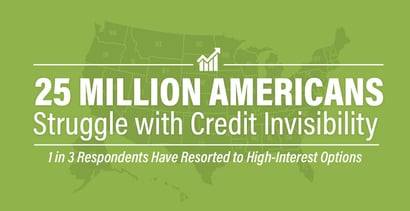
Credit Invisibility describes people whose credit history is so limited that they don’t even have a credit score. According to our recent study, a whopping 25 million Americans are dealing with this issue. This means that they have been denied access to financial products or housing or have faced higher costs due to their lack of sufficient credit history.
The study revealed that the prevalence of credit invisibility varies across states, with Maryland having the highest proportion of credit invisible residents at 746,480 individuals, while Idaho has the lowest at 43,450.
1 in 3 Respondents Have Resorted to High-Interest Options
Those who are credit invisible often have to make some serious financial sacrifices to get their hands on loans or credit. Nearly one-third of those surveyed said they had to resort to high-interest options because they couldn’t access traditional credit.
Some said they had to find a cosigner, make bigger down payments, cut back on spending, or delay big purchases. Others said they were stuck with sky-high interest rates or shorter repayment terms.
Created by badcredit.org • View larger version
And what about emergencies? That’s where things can get really tough. One-third of the credit invisibles surveyed had to borrow money from loved ones, while one-quarter of respondents said they relied solely on their savings. Some survey participants said they even had to sell their belongings, put off important services, or take on side gigs to make ends meet. A small but significant group said they turned to payday loans or cash advances, which can be a slippery slope.
Interestingly, when asked what’s worse — having bad credit or no credit — most people (69%) said bad credit is the bigger headache.
Useful Tips For Attaining Credit Visibility
So, what can we do about this invisible struggle? BadCredit.org Senior Editor Jon McDonald sums it up:
“Credit invisibility is a silent struggle that affects millions of Americans, limiting their access to financial opportunities and hindering their ability to build a stable future. Our study sheds light on this critical issue. We hope that policymakers and financial institutions work together to find solutions that promote financial inclusion and empower those who have been left behind by the traditional credit system.”
BadCredit.org has put together some useful tips on how credit invisibles can build a positive credit history and score:
- Apply for a secured credit card: When you obtain a secured credit card, its credit limit is typically backed by an upfront cash deposit. A secured card can help you build credit through timely payments without spending beyond your means.
- Obtain a credit-builder loan: This financial product is offered by many local financial institutions. The amount you borrow for the loan is typically held in an account while you make monthly payments that are reported to the credit bureaus to help you build credit. Once the “loan” is paid, the money is released to you.
- Don’t apply for too much credit at once. Each time you apply for credit, it results in a hard inquiry on your credit report, which can temporarily lower your score. Space out your applications and apply strategically.
- Pay your bills on time, every time: If you establish an account that reports to credit bureaus, late payments can negatively affect your credit score. Set up automatic payments or reminders to keep yourself on track.
- Keep your credit utilization low. Try to use no more than 30% of your available credit on all your cards combined. This shows lenders that you’re responsible with credit by not over-borrowing to make ends meet.
Survey Methodology
We conducted an online panel survey of 3,000 adults based on age, gender, and geography. Internal data sources are used to obtain population data sets. We used a two-step process to ensure representativeness through stratified sampling and post-stratification weighting.



